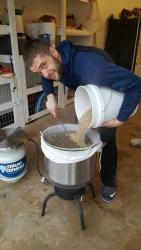Hello. I am new to the forums. I have been reading about, watching videos about and even went to a couple classes about home brewing for the last year or so and think i am finally ready to give it a go. I am looking to brew NE style IPA's.
I currently have no equipment. I dont think I want to just go with a cheap starter set, I am thinking instead of buying quality equipment that would last a long time and hopefully make the process easier thus leading to good consistent beer. Does that plan make sense? Or should i go with some cheap starter set to start and see how it goes? I hate to throw money into throw away equipment.
For example kettles. Most say to brew 5 gallon batches you need at least a 10 gallon kettle. Should I buy a cheap one or go for a Spike or SS Brewtech and be done with it? Obviously it makes the cost of entry more expensive, but as long as I stick with the hobby it would be cheaper long term. Also carboys vs something like a SS Tech conical Fermenter. These are the things I am not sure about at the moment.
Any advise from some experienced brewers?
I currently have no equipment. I dont think I want to just go with a cheap starter set, I am thinking instead of buying quality equipment that would last a long time and hopefully make the process easier thus leading to good consistent beer. Does that plan make sense? Or should i go with some cheap starter set to start and see how it goes? I hate to throw money into throw away equipment.
For example kettles. Most say to brew 5 gallon batches you need at least a 10 gallon kettle. Should I buy a cheap one or go for a Spike or SS Brewtech and be done with it? Obviously it makes the cost of entry more expensive, but as long as I stick with the hobby it would be cheaper long term. Also carboys vs something like a SS Tech conical Fermenter. These are the things I am not sure about at the moment.
Any advise from some experienced brewers?




